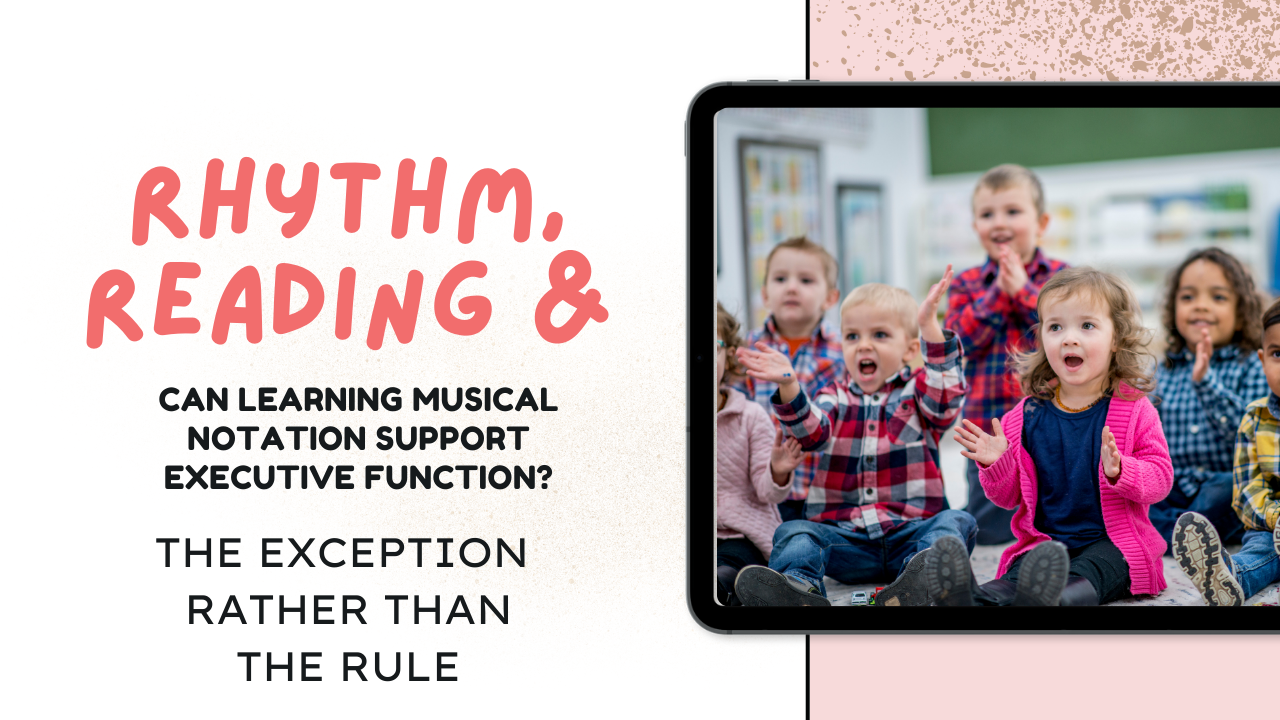A meta analysis on the effects of musical training on speech perception
It is ten years since Frontiers in Psychology published a meta-analysis by Gordon, Fehd and McCandliss (2015) which asked, ‘Does music training enhance literacy skills?’
The authors described a ‘rapidly accumulating body of evidence’ and listed studies that reported significant associations between musical training and language skills (such as Magne et al. 2006).

Some researchers described enhanced brain responses that were the results of musical training, and were measured following an unexpected and unnatural rhythm in the timing and duration of syllables (Chobert et al., 2011). The people who had received musical training were better able to cope with the distortions in spoken language, and the measurements of their brain responses mirrored their enhanced abilities.
A similar effect was obtained in a study that showed enhanced brain responses to irregularities in enunciation (Milanov et al., 2009). Once again the people who had received musical training were better able to understand speech that had been distorted, when compared with the control group.
On the other hand, researchers have also reported statistically significant correlations between musical aptitude (in the absence of musical training) and reading performance (Strait et al., 2011). The authors of the meta analysis, also referred to a study in which ability in musical rhythm explained variation in the production of grammar in six year old children, as well as their production of complex sentence structures in a follow up study (Gordon et al., 2015)
These findings followed earlier studies of musical rhythm, in which an ability to synchronise with a beat predicted children’s performance on tests of phonological awareness, rapid naming of colors and objects (Woodruff Carr et al., 2014), as well as second grade reading skills (Dellatolas et al., 2009) and rhythmically sensitive children also scored better on reading performance in adolescence (Tierney and Kraus, 2013).
What should we make of these findings?
One of the main tasks of a meta analysis is to scrutinize the methods that researchers have used to obtain their results. A major issue is that a wide range of literacy-related outcome measures make judging reliability of the findings more complex.
Firstly, Assessments of reading ability and phonological awareness have been designed to measure different aspects of reading skill: such as reading comprehension, reading rate, reading accuracy, reading fluency and a variety of phonological awareness related skills. Some assessments engage working memory, while others do not and this level of inconsistency has a considerable impact on the data because a working memory task activates a specific main brain network.
Assessments also vary in their formats. Some simply require an individual child to read a list of single words aloud, while others can be administered to groups of children, requiring them to read passages of connected text in silence. To some extent, direct comparisons can be made, but unless these are described in terms of their educational context, teachers cannot make informed decisions about the usefulness of rhythm-based approaches for different reading-related skills.
When researchers use random assignment as a technique to achieve ‘experimental conditions’ in an educational setting, there is a certain amount of naivety surrounding this approach as ‘experimental conditions’ do not (and should not) exist in the ‘noisy’ real world context of a school.
And we can see the real world ‘noise’ of school life in the meta-analysis. The authors discovered that the amount of reading-related support given to children was rarely held constant over time. There were also positive and negative placebo effects - which were triggered in different ways. Based on my own experience, these would include:
social compatibility of the individuals within the ‘treatment’ group,
location of the ‘treatment’ in a room associated with a particular function in the school such as academic support
timing of the ‘treatment’ to always coincide with a particular social or academic slot in the school timetable such as games, art, maths or form time.
All of the studies included in the meta-analysis were peer reviewed. Relatively few studies had used the RCT paradigm, but all of the studies
compared musical training against controls
included before and after comparison measures
indicated that reading intervention had been held constant across groups.
Out of 4855 publications, only 13 research studies fulfilled these requirements and were included in the meta-analysis.
Three of these studies controlled for IQ and SES; they obtained very large effect sizes, for musical training on word reading and on phonological skills. Many more research papers have been published since this important meta analysis was undertaken - stay tuned to this page for an update.
Enjoy this post? Why not keep reading...

REFERENCES
Chobert, J., Marie, C., Francois, C., Schön, D., and Besson, M. (2011). Enhanced passive and active processing of syllables in musician children. J. Cogn. Neurosci. 23, 3874–3887. doi: 10.1162/jocn_a_00088
Dellatolas, G., Watier, L., Le Normand, M. T., Lubart, T., and Chevrie-Muller, C. (2009). Rhythm reproduction in kindergarten, reading performance at second grade, and developmental dyslexia theories. Arch. Clin. Neuropsychol. 24, 555–563. doi: 10.1093/arclin/acp044
Gordon RL, Fehd HM and McCandliss BD (2015) Does Music Training Enhance Literacy Skills? A Meta-Analysis. Front. Psychol. 6:1777.
Gordon, R. L., Shivers, C. M., Wieland, E. A., Kotz, S. A., Yoder, P. J.,and Devin McAuley, J. (2015). Musical rhythm discrimination explains individual differences in grammar skills in children. Dev. Sci. 18, 635–644. doi: 10.1111/desc.12230
Magne, C., Schön, D., and Besson, M. (2006). Musician children detect pitch violations in both music and language better than nonmusician children: behavioral and electrophysiological approaches. J. Cogn. Neurosci. 18, 199–211. doi: 10.1162/jocn.2006.18.2.199
Milovanov, R., Huotilainen, M., Esquef, P. A., Alku, P., Välimä ̈ki, V., and Tervaniemi, M. (2009). The role of musical aptitude and language skills in preattentive duration processing in school-aged children. Neurosci. Lett. 460, 161–165. doi: 10.1016/j.neulet.2009.05.063
Patel, A. D. (2011). Why would musical training benefit the neural encoding of speech? The OPERA hypothesis Front. Psychol. 2:142 doi:10.3389/fpsyg.2011.00142
Strait, D. L., Hornickel, J., and Kraus, N. (2011). Subcortical processing of speech regularities underlies reading and music aptitude in children. Behav. Brain Funct. 7:44. doi: 10.1186/1744-9081-7-44
Tierney, A. T., and Kraus, N. (2013b). The ability to tap to a beat relates to cognitive, linguistic, and perceptual skills. Brain Lang. 124, 225–231. doi: 10.1016/j.bandl.2012.12.014
Woodruff Carr, K., White-Schwoch, T., Tierney, A. T., Strait, D. L., and Kraus, N. (2014). Beat synchronization predicts neural speech encoding and reading readiness in preschoolers. Proc. Natl. Acad. Sci. U.S.A. 111, 14559–14564. doi: 10.1073/pnas.1406219111




